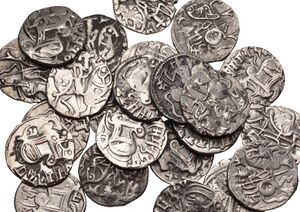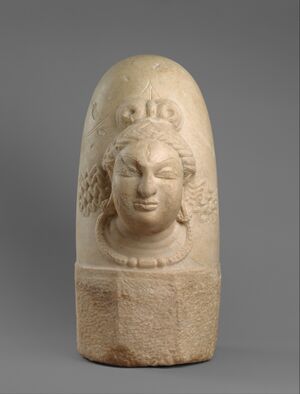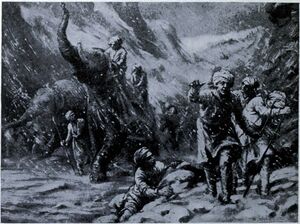هندو شاهي
Hindu Shahi | |||||||||||||
|---|---|---|---|---|---|---|---|---|---|---|---|---|---|
| 850–1026 م | |||||||||||||
الموقع التقريبي لهندو شاهي | |||||||||||||
| الوضع | امبراطورية | ||||||||||||
| العاصمة |
| ||||||||||||
| الدين | Hinduism | ||||||||||||
| الحكومة | Monarchy | ||||||||||||
| Shahi | |||||||||||||
| الحقبة التاريخية | Early Middle Ages | ||||||||||||
• تأسست | 850 | ||||||||||||
• انحلت | 1026 م | ||||||||||||
| |||||||||||||
| اليوم جزء من | Afghanistan
Pakistan | ||||||||||||
The Hindu Shahis[4] (850–1026 CE) was a Hindu dynasty that held sway over the Kabul Valley, Gandhara and western Punjab during the early medieval period in the Indian Subcontinent. Details regarding past rulers have been assembled from chronicles, coins and stone inscriptions by researchers as no consolidated account of their history has become available.[5]
التاريخ
The Abbasids led by caliph Al-Ma'mun defeated the Turk Shahi Kingdom in 815 CE. After this defeat, the Turkic Shah had to convert to Islam and had to pay on annual basis 1,500,000 Dirhams and also slaves to the Abbasids.[6] These Kabul Shahis went through a political disaster due to the defeats and annual payments. Eventually, around 821 CE the unpopular Kabul Shah Lagaturman was disposed of his position by his minister called Kallar.[7] This gave way to another Kabul Shahi dynasty. This new dynasty was called "Hindu Shahi" by the Arabs, this novel Shahi kingdom possessed the Kabul Valley and Gandhara.[6]
In 870, King Kallar lost the city of Kabul. He was displaced from there by the local Saffarid dynasty which was ruled by Emir Ya'qub bin Laith as-Saffar. Due to the ongoing conquests of the local Saffarids and Samanids, he moved his capital in 870 to Udabhandapura (Also called Waihund or Hund), located on the banks of the Indus.[8][9] The loss of Kabul remained short as in 879 CE the Hindu Shahi captured the city back. This victory remained short too due to Samanid expansion in the region which eventually led to the final Shahi rule in Kabul around 900 CE. The Hindu Shahi remained strong in Gandhara and other parts of the Punjab.[6]
The varna of Shahis of Kabul
Al-Biruni, (973-1050) the Iranian Sanskritist and polymath who lived in India contemporary to the reign of the Hindu Shahi's said their varna was Brahmin. [10] According to R.C.Majumdar, the Hindu Shahi Kingdom was founded by the Brahmin minister Kallar who killed Muslim Shah and occupied the throne. Mohyal, Vaid and Bali clans also claim ancestry from this dynasty. [11]
The Amb Hindu Temple complex was built between the 7th and 9th centuries CE during the reign of the Hindu Shahi Empire.[12]
Coins of the Hindu Shahis, which later inspired Abbasid coins in the Middle East.[13]
In 1973, Historian Yogendra Mishra projected the view[14] that according to Rajatarangini Hindu Shahis (meaning here post-Lagaturman kings) were Kshatriyas or Rajputs. However, Mishra admits this view of his is based on the Rajatarangini which was 119 years after Al-Biruni & hence not a contemporary souce.
Defence of Kabul by Hindu Shahis
It can be surmised that there were consanguineous and political relationships between the states of Kabul and Zabul. At some stage, the kingdom had split up. Its western part formed a separate state called the kingdom of Zabul, while the eastern part became the Turk Shahi.[15]
In 700-701, Abdur-Rahmān ibn Muhammad ibn Al-Ash’ath was dispatched with forty thousand men and was able to collect considerable booty but failed to have any territorial gains – thus incurring the displeasure of Hajjaj. Exasperated by the threats of supersession he determined to carry arms against his master and, in order to strengthen his power, conducted a treaty with the Rutbils that the latter would afford him asylum in the event of the failure of his campaign against the caliph. After some initial successes, Abdur Rahman was at the end compelled to seek the protection of his non-muslim ally. Sustained political intervention of the Rutbil brought the Islamic expansion to a halt and he had made Sistan an ‘ill-omened frontier’ for the Arabs. In folklore Rutbil became the hero of many Arab stories of holy wars on the frontier of Hind. Gradually, the Arabs - the ruling caliphs - ceased to be a powerful political force and Rutbils ruled in comparative peace for another one hundred and fifty years.[16]
Islamic kingdoms in the Shahi neighbourhood
The Samanids and the Saffarids
In theory, the caliph as the successor of the Prophet was the fountainhead of all political authority. Kings and all tribal chiefs were subordinate to him and his sanction alone could provide the legal basis for their authority. With the waning of political might of the caliphate, its governors in Khurasan set up their own strong kingdom – the Samanid dynasty (c. 819-1005 CE) – controlling regions west and north of Hindu Kush up to Balkh. Under the loosely centralized feudal government of the Samanids, Transoxiana and Khurasan prospered with a notable expansion of industry and commerce. Samanids were great art patrons and they turned Bukhara and Samarkand into famous cultural centres, rivaling Baghdad.[17]
The Hindu Shahi Dynasty of Kabul
According to The Mazare Sharif Inscription of the Time of the Shahi Ruler Veka, recently discovered from northern Afghanistan and reported by the Taxila Institute of Asian Civilisations, Islamabad, Veka (sic.) conquered northern region of Afghanistan ‘with eightfold forces’ and ruled there. He established a Shiva temple there which was inaugurated by Parimaha Maitya (the Great Minister).[18] He also issued copper coins of the Elephant and Lion type with the legend Shri Vakkadeva.[بحاجة لمصدر]
Nine principal issues of Bull and Horseman silver coins and only one issue of corresponding copper coins of Spalapatideva have become available. As many as five Elephant and Lion type of copper coins of Shri Vakkadeva are available and curiously the copper issues of Vakka are contemporaneous with the silver issues of Spalapati.[19]
Kabul Town not attacked
On his way back from Balkh, Yaqub is stated to have attacked Kabul. "Whether the word Kabul stands here for the city in particular or Kabul valley in general, is not clearly stated. The sequence of events, however, suggests that latter was probably the case" (Abdur Rahman).[20] As we know, Shahis had a governor in Northern Afghanistan. Invasion of this province was an attack on (the state of) Kabul and the idols, say from the Shiva temple established by Vakkadeva would verily be ‘idols from Kabul’. There is no indication of a direct battle between Yaqub and the king of Kabul, which event could not go unreported.[21]
It was some time during this period that the Hindu Shahis shifted their capital from Kabul to Udabhandapura.[بحاجة لمصدر]
Kamalavarman attacks Ghazni
Reliable evidence has now become available indicating that this oft-quoted narration by ‘Ufi was short of the ‘whole truth’. Kamlu did not stop in his tracks by Fardaghan's ingenious propaganda. Tarikh-i-Sistan illuminates the history of this period differently. Amr-i-Lais's pre-occupation with affairs in Khurasan and the provocative action of his newly appointed governor of Ghazni, prompted two Indian Kings (Rai of Hindustan), whose names reported in very corrupt form have been restored as Ashta and Tormana, to take firm retaliatory measures. They combined their forces and launched a united invasion of Ghazni. Fardaghan is said to have opposed the Hindu army. The Tarikh does not tell us whether the city of Ghazni was actually occupied by the victors at this stage or the name Ghazni stands for the province of Zabulistan, and not the city of Ghazni. The news of this invasion reached Amr when he was in Gurgan on his way to his last encounter with Ismail. In April 900 Amr was decisively defeated and sent as a prisoner to Baghdad where he breathed his last. He must have passed through Gurgan only a couple of months before his defeat. Thus Kamlu's invasion of Zabulistan can safely be placed in the beginning of 900 at the latest.[25]
Having successfully dealt with the Saffarids, Ashta (the governor of Kabul) appears to have stayed back and maneuvered a ‘palace coup’. He seized the Shahi throne at Udabhandapura, dislodging his brother Kamalavarman but the state of Kashmir intervened. Rajatarangini records that Prabhakaradeva the Koshadhyaksha (Superintendent of Treasury) led a victorious expedition against the Shahi power at the town of Udabhandapura and bestowed the kingdom of the rebellious Shahi (Ajna Atikrami Shahi – a Shahi violator of order) upon Tormana, Lalliya's son and gave him the new name Kamaluka. This may have happened in 903 during the reign of child king Gopalavarman (r. 902-904) ruling under the guardianship of his mother Sugandha.[بحاجة لمصدر]
Kamaluka has been identified as Kamalavarman, son of Lalliya (Samantadeva). He was succeeded by his son, Bhimadeva.[بحاجة لمصدر]
Bhimadeva
Hindu rule at Ghazni
During the reign of Kamalavarman, the Saffarid rule weakened precipitately and ultimately Sistan became a part of the Samanid Empire. The disorder generally prevailed and the control of Zabulistan changed hands frequently. Taking advantage of the situation, the Shahis stepped up activities on their western frontier. The result was the emergence of a small Hindu power at Ghazni, supported by the Shahis. "The authorities either themselves of early date or enshrining early information mention Lawik" who was a Buddhist as the ruler at Ghazni, before this place was taken over by the Turkish slave governor of the Samanids.[26]
By the middle of the tenth century, Turkish slaves began to acquire power in the Samanid realm, as they were holding principal offices in the court and kingdom. One of these, Alaptagin, a former Hajib or Door Keeper, defeated the superior royal army near Khulm Pass and decided to carve out an independent kingdom for himself. He first took over Bamian ‘the country of the infidel (Hindu) Shir Barak’. He next turned to Ghazni where Lawik, its ruler, submitted after a prolonged siege of four months. Alaptagin thus became the undisputed master of Ghazni but he died soon thereafter and his son Abu Ishaq succeeded him in 963.[بحاجة لمصدر]
Substitution of Hindu potentates of Bamian and Ghazni by an emerging Turkish power posed a serious threat to the Shahi kingdom which acted with ‘remarkable alacrity’ at this stage. The Lawik was sent back to Ghazni with a huge army which ousted the Turks and sent Abu Ishaq flying to Bukhara. The Shahis had secured their western frontier – for the time being. But the gathering storm had not blown away.[بحاجة لمصدر]
Bhimadeva and Kashmir
Bhimadeva had only one daughter named Shreelekha and no son. This daughter was married to Simhraja of the Lohara dynasty.[بحاجة لمصدر]
End of Bhimadeva
The Shahi state had successfully managed to ward off danger from the strong neighbouring kingdom of the Samanids for more than a century. That Muslim kingdom was gradually decaying but its ambitious Turk officers were acquiring power and setting up personal fiefdoms, menacing the Hindu states south of Koh Hindu Kush. Though ruling with grandeur, unmolested by any neighbouring kingdom, Bhimadeva was getting old and must have been weighing his options in the matter of succession, because he did not have a male heir. The Shahi kingdom was strong and prosperous but not easy to govern - and protect. He could not count either on the Lawiks or his granddaughter Didda of Kashmir for this onerous responsibility. He selected the allied kingdom of Punjab for this honour and probably installed a successor in his own life for the succession seems to have been without ‘contest or convulsion’.[27]
Jayapaladeva
With Jayapala, a new dynasty started ruling over the former Shahi kingdom of southeastern Afghanistan and the change over was smooth and consensual. On his coronation, Jayapala used the additional name-suffix Deva from his predecessor's dynasty in addition to the pala name-ending of his own family. (With Kabul lost during the lifetime of Jayapaladeva, his successors – Anandapala, Trilochanapala and Bhimapala - reverted to their own family pala-ending names.) Jayapala did not issue any coins in his own name. Bull and Horseman coins with the legend Samantadeva, in billon, seem to have been struck during Jayapala's reign. As the successor of Bhima, Jayapala was a Shahi monarch of the state of Kabul, which now included Punjab. Minhaj-ud-din describes Jayapala as "the greatest of the Rais of Hindustan."[29]
From the beginning, Jayapala followed an aggressive and pro-active policy towards the Turks. As stated earlier, Abu Ishaq had been evicted from Ghazni and the Lawiks were installed there with Shahi help. In 965, Abu Ishaq regained Ghazni with assistance from the Samanid ruler Abu Mansur and the Lawik fled to ‘Hind’ once again to seek help from the Shahis. Ultimately, Sabuktagin descended the throne of Ghazni in 977. He soon added Bust, Dawar, Qusdar, Tukhristan and Ghur to his dominions. Conflict with ‘Hind’ could not have been postponed for too long.[بحاجة لمصدر]
Jayapaladeva attacks Sabuktagin
Jayapaladeva attacked the growing power Sabuktagin and was a fierce battle in which Jayapala was defeated. He lost more territory but continued to rule from Waihind and Peshawar.[بحاجة لمصدر]
Sabuktagin then became more involved in the affairs of the Samanid state and left the Shahis in peace. He became very powerful in the Samanid Kingdom by virtue of his strong and disciplined army. Sabuktagin died at Balkh in 997 at the age of fifty six.
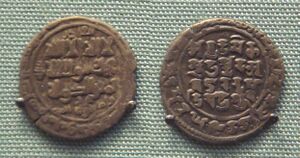
After a struggle for succession with brothers, his son Mahmud of Ghazni ascended the throne of Ghazni in 998. Mahmud first consolidated his position on his western front, even if he had to challenge the authority of his Samani over-lord. Soon he had control over Herat, Balkh, Bust and Khurasan. Recognising his power, the Caliph of Baghdad acknowledged him as a sovereign in his own right and conferred high sounding titles on him. The Ghaznavids had thus acquired a status equal to their former masters – the Samanids. The balance of power had been gradually tilting in favour of Ghazni.
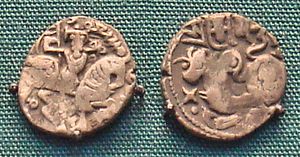
The Turk Shahis had resisted for more than 200 years to the eastward expansion of the Muslim forces of the Abbasid Caliphate, effectively blocking the Muslim conquests in India, until they fell to the Persian Saffarids in the 9th century CE. The long resistance of the Turk Shahis against Muslim expansion may have contributed to the preservation of Indian culture and Hinduism, as "the militant process of conversion" to Islam in conquered lands, which had deeply affected the Near East and the Iranian world, already "was a thing of the past" in the 10th century CE.[30]
The Persiante Turkic Ghaznavids finally broke through into India after overpowering the declining Hindu Shahis and Gurjaras.[31][30][32] Mahmud of Ghazni initiated the first of numerous invasions of North India. On 28 November 1001, his army fought and defeated the army of Raja Jayapala of the Turk Shahis at the Battle of Peshawar. In 1002 Mahmud invaded Sistan and dethroned Khalaf ibn Ahmad, ending the Saffarid dynasty.[33] From there he decided to focus on Hindustan to the southeast, particularly the highly fertile lands of the Punjab region.
Rulers
According to available inscriptions following are the names of Hindu Shahi kings:[19][27][29]
- Vakkadeva
- Kamalavarman
- Bhimadeva
- Jayapala (964 to 1001 CE)
- Anandapala (1001 to 1010 CE)
- Trilochanapala (1010 to 1021 CE)
- Bhimpala (1021 to 1026 CE)
See also
المصادر
- ^ Schwartzberg, Joseph E. (1978). A Historical atlas of South Asia. Chicago: University of Chicago Press. p. 146, map XIV.2 (j). ISBN 0226742210.
- ^ Wynbrandt, James (2009). A brief history of Pakistan. Facts On File. p. 45. ISBN 9780816061846.
- ^ Wink, André (2002). Al-Hind: The Slavic Kings and the Islamic conquest, 11th-13th centuries (in الإنجليزية). BRILL. ISBN 978-0-391-04174-5.
Lahore appears as the capital of the Panjab for the first time under Anandapala, the Hindu Shahi king — who is ...
- ^ Balogh, Dániel (12 March 2020). Hunnic Peoples in Central and South Asia: Sources for their Origin and History (in الإنجليزية). Barkhuis. p. 362. ISBN 978-94-93194-01-4.
- ^ Rafi U. Samad (2011). The Grandeur of Gandhara: The Ancient Buddhist Civilization of the Swat, Peshawar, Kabul and Indus Valleys. Algora Publishing. pp. 275–. ISBN 978-0-87586-860-8.
- ^ أ ب ت "16. The Hindu Shahis in Kabulistan and Gandhara and the Arab conquest | Digitaler Ausstellungskatalog". pro.geo.univie.ac.at. Retrieved 26 March 2020.
- ^ "Proceedings of the Indian History Congress Vol. 61, Part One: Millennium (2000-2001), pp. 132 https://www.jstor.org/stable/44148087"
- ^ Chopra, P.N (2003). A Comprehensive History Of Ancient India (3 Vol. Set) (in الإنجليزية). Sterling Publishers Pvt. Ltd. ISBN 978-81-207-2503-4.
- ^ Kumāra, Braja Bihārī (2007). India and Central Asia: Classical to Contemporary Periods (in الإنجليزية). Concept Publishing Company. ISBN 978-81-8069-457-8.
- ^ Edward C. Sachau (1910-06-30). Al-BIRUNI'S INDIA.
- ^ R. C. Majumdar, General Editor (2009). History and Culture of the Indian People, Volume 04, The Age Of Imperial Kanauj. Public Resource. Bharatiya Vidya Bhavan. p. 112.
{{cite book}}:|first=has generic name (help) - ^ Gazetteer of the Attock District, 1930, Part 1. Sang-e-Meel Publications. 1932. Retrieved 21 September 2017.
- ^ André Wink (June 1991). Al- Hind: The slave kings and the Islamic conquest. 2. BRILL. pp. 127–. ISBN 978-90-04-09509-0.
- ^ Yogendra Mishara, The Hindu Shahis of Afghanistan and the Punjab AD 865-1026, p. 4.
- ^ Abdur Rahman, Last Two Dynasties of the Shahis: "In about AD 680, the Rutbil was a brother of the Kabul Shahi. In AD 726, the ruler of Zabulistan (Rutbil) was the nephew of Kabul Shah. Obviously the Kabul Shahs and the Rutbils belonged to the same family" – pp. 46 and 79, quoting Tabri, I, 2705-6 and Fuch, von W.
- ^ See: H. M. Elliot and John Dowson, The History of India, as Told by Its Own Historians, Vol. I, p. 429 and Vol. II, p. 416-417; André Wink, Al-Hind, pp. 121-123; K. A. Nizami, ed. Politics and Society during the Early Medieval Period, Vol. II, p.37 ff
- ^ C. V. Vaidya, History of Mediaeval Hindu India, Vol. III, pp. 8-13; and others.
- ^ See R. T. Mohan, AFGHANISTAN REVISITED … Appendix – A, pp. 162-163.
- ^ أ ب D. W. Macdowall, "The Shahis of Kabul and Gandhara" Numismatic Chronicle, Seventh Series, Vol. III, 1968, pp. 189-224, see extracts in R. T. Mohan, AFGHANISTAN REVISITED … Appendix –B, pp. 164-68
- ^ Abdur Rahman, The Last Two Dynasties of the Shahis, pp. 101-103
- ^ The Last Two Dynasties of the Shahis, p. 102.
- ^ "Metropolitan Museum of Art". www.metmuseum.org.
- ^ Kossak, Steven; Lerner, Martin (1994). "The Arts of South and Southeast Asia". The Metropolitan Museum of Art Bulletin. 51 (4): 35–37.
- ^ The Metropolitan Museum of Art. Vol. 10, Asia. The Metropolitan Museum of Art. 1987. p. 129.
- ^ Abdur Rahman, The Last Two Dynasties of the Shahis, pp. 110-116 quoting Tarikh-i-Sistan, pp. 255-56. Also, André Wink, Al-Hind, I, p. 125: "Muslim control of Zamindwar remained imperfect until the end of the ninth century, and in Ghazni, the Saffarid governor was again expelled by two Indian princes in 890-900 CE"
- ^ C. E. Bosworth, ‘Notes on Pre-Ghaznavid History of Eastern Afghanistan, Islamic Quarterly, Vol. XI, 1965.
- ^ أ ب Raizada Harichand Vaid, Gulshane Mohyali, II, pp. 83 and 183-84.
- ^ Hutchinson's story of the nations, containing the Egyptians, the Chinese, India, the Babylonian nation, the Hittites, the Assyrians, the Phoenicians and the Carthaginians, the Phrygians, the Lydians, and other nations of Asia Minor. London, Hutchinson. p. 150.
- ^ أ ب H. G. Raverty, Tr. Tabaqat-i-Nasiri of Maulana Minhaj-ud-din, Vol. I, p. 82
- ^ أ ب Kim, Hyun Jin (19 November 2015). The Huns (in الإنجليزية). Routledge. pp. 62–64. ISBN 978-1-317-34091-1.
- ^ "Contained within a clay urn were a gold bracteate with the portrait of a ruler, three early drachms of the Turk-Shahis (Type 236, one of which is countermarked), and a countermarked drachm of the Sasanian king Khusro II dating from year 37 of his reign (= 626/7). The two countermarks on Khusro 's drachm prove that the urn could only have been deposited after 689" ALRAM, MICHAEL (2014). "From the Sasanians to the Huns New Numismatic Evidence from the Hindu Kush" (PDF). The Numismatic Chronicle. 174: 282–285. ISSN 0078-2696. JSTOR 44710198.
- ^ Alram, Michael; Filigenzi, Anna; Kinberger, Michaela; Nell, Daniel; Pfisterer, Matthias; Vondrovec, Klaus. "The Countenance of the other (The Coins of the Huns and Western Turks in Central Asia and India) 2012-2013 exhibit: 16. THE HINDU SHAHIS IN KABULISTAN AND GANDHARA AND THE ARAB CONQUEST". Pro.geo.univie.ac.at. Kunsthistorisches Museum Vienna. Retrieved July 22, 2017.
- ^ Bosworth 1963, p. 89.
المراجع
- Bosworth, C.E. (1963). The Ghaznavids 994–1040. Edinburgh University Press.
- Bosworth, C.E. (1991). "Mahmud bin Sebuktigin". Encyclopedia of Islam. E.J.Brill. VI.
- CS1: Julian–Gregorian uncertainty
- CS1 errors: generic name
- Short description is different from Wikidata
- Former country articles categorised by government type
- مقالات ذات عبارات بحاجة لمصادر
- Articles with unsourced statements from November 2014
- Articles with unsourced statements from July 2013
- Articles with unsourced statements from February 2018
- Articles with unsourced statements from September 2020
- Articles with hatnote templates targeting a nonexistent page
- أفغانستان العصور الوسطى
- الهندوسية في أفغانستان
- كابول شاهي
- أسرات هندية
- بلدان سابقة في وسط آسيا
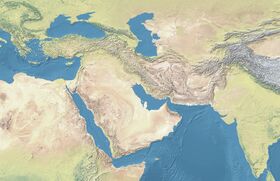
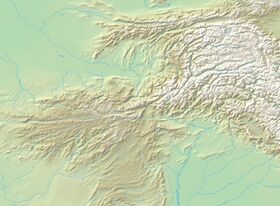
![The Amb Hindu Temple complex was built between the 7th and 9th centuries CE during the reign of the Hindu Shahi Empire.[12]](/w/images/thumb/2/24/AMB_Temple_in_Soon_Sakasar_Valley_by_Usman_Ghani.JPG/299px-AMB_Temple_in_Soon_Sakasar_Valley_by_Usman_Ghani.JPG)
![Coins of the Hindu Shahis, which later inspired Abbasid coins in the Middle East.[13]](/w/images/thumb/0/09/Coins_of_the_Shahis_8th_century.jpg/300px-Coins_of_the_Shahis_8th_century.jpg)
